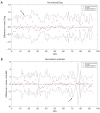Cortical morphological alterations and structural covariant network topology changes in children with acute lymphoblastic leukemia
- PMID: 41209195
- PMCID: PMC12591750
- DOI: 10.21037/qims-24-2239
Cortical morphological alterations and structural covariant network topology changes in children with acute lymphoblastic leukemia
Abstract
Background: The mechanisms underlying chemotherapy-induced cognitive impairment (CICI) and structural brain changes in children with acute lymphoblastic leukemia (ALL) remain unclear. This study investigated early chemotherapy-induced alterations in cortical morphology and structural covariance network (SCN) reorganization in children with ALL.
Methods: In total, 26 children (7.07±3.09 years old) with ALL were included in the study. A surface-based morphometry (SBM) analysis was carried out to estimate changes in cortex morphology in the children with ALL. A statistical analysis of cortical morphological changes using the paired t-test (P<0.05) with family-wise error (FWE) correction was conducted. The global and local SCN parameters of the brain covariance network were calculated. A statistical analysis was performed using the 1,000-permutation test (P<0.05) with a false discovery rate to correct the attributes of the local network.
Results: On days 46-52 of chemotherapy, the cortical thickness of multiple brain regions in children with ALL became extensively thinner (cluster size ≥50, P<0.05, FWE corrected). The gyrification index was reduced in the bilateral frontal lobe and right insula. A fractal dimension reduction was observed in the left inferior medial frontal gyrus. The degree (Deg) in the left supplementary motor area (LSMA; P=0.029) increased, and the betweenness (Bet) in the left precuneus (LPCUN) decreased (P=0.034). However, no statistically significant differences were found between the other parameters, including the clustering coefficient (Cp; P=0.159), local efficiency (Eloc; P=0.325), characteristic path length (P=0.522), global efficiency (Eg; P=0.702), assortativity (P=0.956), transitivity (P=0.753), and modularity (P=0.628). The absence of contemporaneous neurocognitive assessments precluded the exploration of relationships between cortical morphological alterations/SCN changes and neurocognition.
Conclusions: On days 46-52 of chemotherapy, changes in the morphology of the cerebral cortex, and changes in the Deg, Bet, and hub values in the SCN were already present in children with ALL. The bilateral frontal lobe may be the most susceptible brain region for CICI among children with ALL. These results appear to suggest that the topological properties in the brains of these children were reorganized as a compensatory mechanism after chemotherapy.
Keywords: Acute lymphoblastic leukemia (ALL); chemotherapy-induced cognitive impairment (CICI); magnetic resonance imaging (MRI); structural covariance network (SCN); surface-based morphometry (SBM).
Copyright © 2025 AME Publishing Company. All rights reserved.
Conflict of interest statement
Conflicts of Interest: All authors have completed the ICMJE uniform disclosure form (available at https://qims.amegroups.com/article/view/10.21037/qims-24-2239/coif). The authors have no conflicts of interest to declare.
Figures





References
-
- Stoltze U, Junk SV, Byrjalsen A, Cavé H, Cazzaniga G, Elitzur S, Fronkova E, Hjalgrim LL, Kuiper RP, Lundgren L, Mescher M, Mikkelsen T, Pastorczak A, Strullu M, Trka J, Wadt K, Izraeli S, Borkhardt A, Schmiegelow K. Overt and covert genetic causes of pediatric acute lymphoblastic leukemia. Leukemia 2025;39:1031-45. 10.1038/s41375-025-02535-4 - DOI - PubMed
-
- Cheung YT, Sabin ND, Reddick WE, Bhojwani D, Liu W, Brinkman TM, Glass JO, Hwang SN, Srivastava D, Pui CH, Robison LL, Hudson MM, Krull KR. Leukoencephalopathy and long-term neurobehavioural, neurocognitive, and brain imaging outcomes in survivors of childhood acute lymphoblastic leukaemia treated with chemotherapy: a longitudinal analysis. Lancet Haematol 2016;3:e456-66. 10.1016/S2352-3026(16)30110-7 - DOI - PMC - PubMed
LinkOut - more resources
Full Text Sources
Miscellaneous
